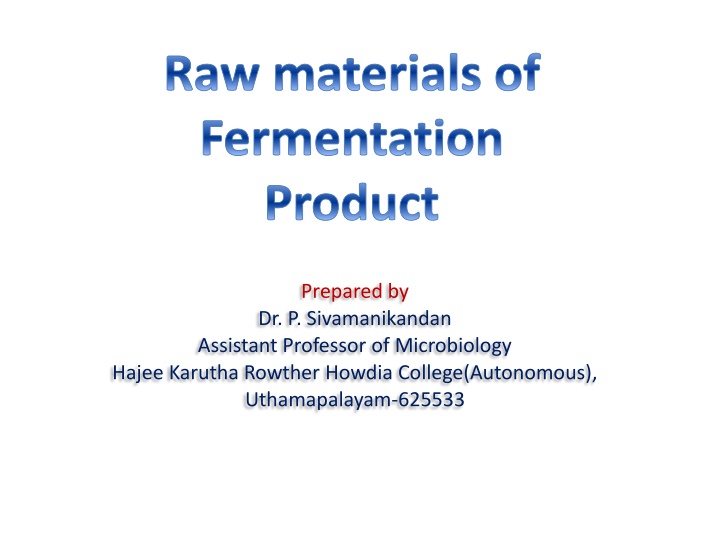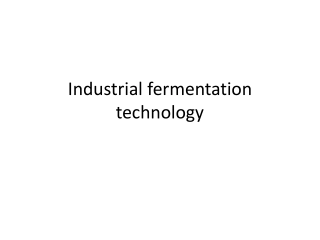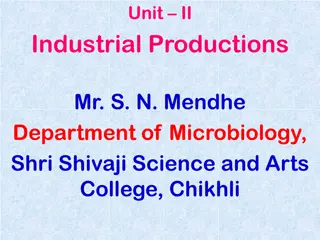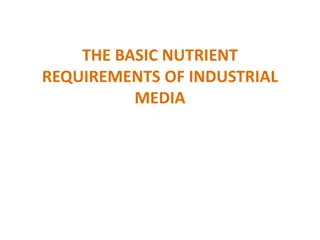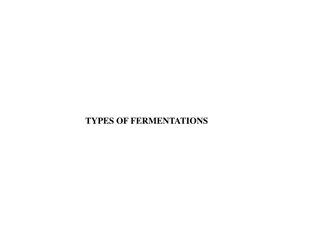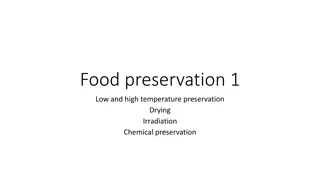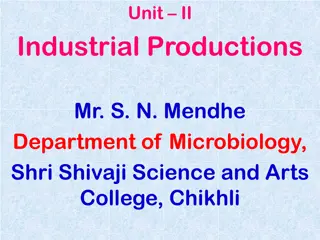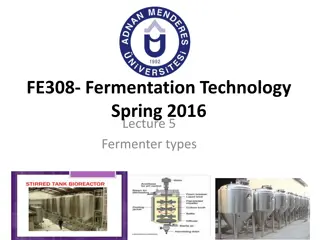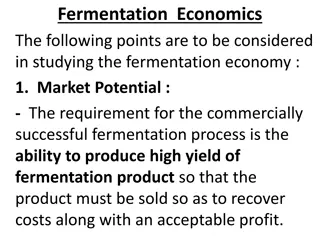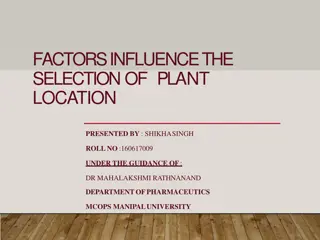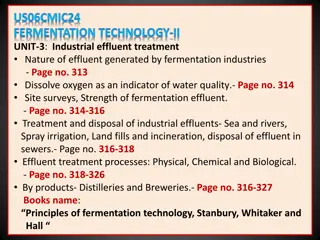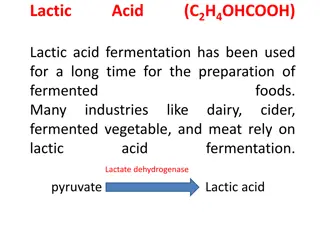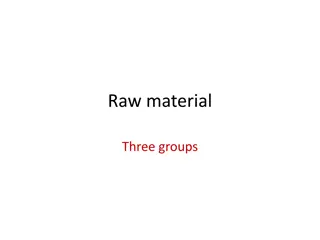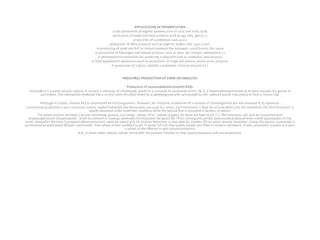Raw Materials in Industrial Fermentation Processes
Microorganisms utilized in industrial fermentation require essential raw materials such as water, energy sources, carbon, nitrogen, mineral elements, and sometimes vitamins and oxygen. Various raw materials like cane molasses, beet molasses, cereal grains, starch, glucose, and lactose serve as carbon sources, while ammonium salts, urea, and other nitrogen sources are used for production media. The cost, availability, handling, and health implications of raw materials are crucial factors in fermentation processes. Carbon sources play a vital role in growth, product formation, and energy generation in microbial fermentations. Molasses, a byproduct of sugar production, is commonly used due to its carbohydrate content.
Download Presentation

Please find below an Image/Link to download the presentation.
The content on the website is provided AS IS for your information and personal use only. It may not be sold, licensed, or shared on other websites without obtaining consent from the author.If you encounter any issues during the download, it is possible that the publisher has removed the file from their server.
You are allowed to download the files provided on this website for personal or commercial use, subject to the condition that they are used lawfully. All files are the property of their respective owners.
The content on the website is provided AS IS for your information and personal use only. It may not be sold, licensed, or shared on other websites without obtaining consent from the author.
E N D
Presentation Transcript
Raw materials of Fermentation Product Prepared by Dr. P. Sivamanikandan Assistant Professor of Microbiology Hajee Karutha Rowther Howdia College(Autonomous), Uthamapalayam-625533
Introduction All micro-organisms require water, sources of energy, carbon, nitrogen, mineral elements and possibly vitamins and oxygen if aerobic. The use of cane molasses, beet molasses, cereal grains, starch, glucose, sucrose and lactose as carbon sources, and ammonium salts, urea, nitrates, corn steep liquor, Soya bean meal, slaughter-house waste and fermentation residues as nitrogen sources, for the production media. Many different types of raw material are used in different types of industrial fermentation processes. Mostly agricultural products are utilized as sources of raw material in fermentation industries.
The main features that involve the raw materials are as follows. Cost and availability: ideally, raw materials should be low- cost and constant quality. Easy of handling in solid or liquid forms, along with associated transport and storage These wastes contain a large amount of proteins and carbohydrates. The concentration of target product reached its rate of formation and yield per gram of substrate utilized. Overall health and safety implications.
Carbon sources Carbon sources are the major components of media. It is building blocks for growth and product formation. The carbon sources give fast growth and depress the formation of some products. A carbon source is required for all biosynthesis important to reproduction, product formation and cell maintenance. As most carbon substrates also serve as energy sources, the organism s efficiency of both adenosine triphosphate (ATP) generation. Animal fats and plant oils may also be included into some media, often as increase to the main carbon source. Carbohydrates are the energy sources for microbial fermentations, may be used as alcohols, alkanes and organic acids.
For commercial fermentations the determination of yield coefficients for all other nutrients is usually essential. For example, Saccharomyces cerevisiae grown on glucose has biomass yield coefficients of 0.56 and 0.12 g under aerobic and anaerobic conditions, respectively. Molasses Pure glucose and sucrose are rarely used for industrial scale fermentations, primarily due to cost. Molasses is a byproduct of the cane and beet sugar production. It is recovered at several stages in the sugar refining industry. It is dark coloured thick syrup containing 50 60% (w/v) carbohydrates, primarily sucrose, with 2% (w/v) nitrogenous substances, along with some vitamins and minerals.
Cane Molasses Cane molasses is rich in vitamin such as biotin, Pantothenic acid, thiamine, phosphorous and sulphur also present. It is a cheaper and more natural source of sucrose. The chemical composition of sugar cane molasses is water 20%, Ash 8%, Total sugar 40 -60%, Total nitrogen bodies 3%, Total nitrogen 0.5%, gums 2%, free acids 2%, combined acids 3%. About 95% of the total sugar in cane molasses is fermentable. The organic nitrogen content is less than beet molasses. It dose not contain betaine.
Beet molasses Beet molasses are produced by the same processes employed for cane molasses. Beet molasses is rich in vitamin such as biotin, pyridoxine, Pantothenic acid, thiamine and inositol, are also present. It is a cheaper and more natural source of sucrose. The chemical composition of beet molasses is Sucrose 48 -50%, Raffinose 1%, Glucose + fructose 1%, Nitrogen compounds 12 -13%, glutamic acid 3 - 5%, Betaine 3.25 4.25%, Ash 11- 12%. The largest utilization of cane molasses in India at present used in the alcohol industry for the manufacture of ethyl alcohol (sprit) and other liquor such as rum, brandy, gin and whiskey.
Malt Extract Aqueous extracts of malted barley can be concentrated to form syrups that are particularly useful carbon sources for the cultivation of filamentous fungi, yeasts and Actinomycetes. The composition of malt extracts varies to 90% carbohydrate including 20% hexoses, 55% disaccharides and 10% maltotriose, a trisaccharide and also contains some vitamins and nitrogenous substances, proteins, peptides and amino acids.
Whey Whey is an aqueous byproduct of the dairy industry. They straw coloured liquid produced as a byproduct of cheese industry. It is a main waste product for the cheese industry. It cannot be disposed of without proper treatment. This material is expensive to store and transport. Therefore, lactose concentrates are prepared for later fermentation by evaporation of the whey, following removal of milk proteins for use as food supplements. This disaccharide was formerly used in penicillin fermentations and it is still employed for producing ethanol, single cell protein, lactic acid, vitamin B12 and gibberellic acid.
Sulfite Waste Liquor In the manufacture of paper pulp, wood is subjected to hydrolysis is brought about with help of calcium bisulfite under heat and pressure. At the end of this process, the spent liquid is formed. This liquid is called Sulfite Waste Liquor. Waste liquors from coniferous trees contain 2 3% (w/v) sugar, which is a mixture of hexoses (80%) and pentoses (20%). Hexoses include glucose, mannose and galactose, whereas the pentose sugars are mostly xylose and arabinose. Sugar containing wastes derived from the paper pulping industry are primarily used for the cultivation of yeasts. Sulfite Waste Liquor obtained from the paper pulp industry cannot be used directly in the fermentations industry. It is essential to remove the free sulfite dioxide present in the waste liquor, since these compounds are toxic to microorganisms.
Nitrogen sources Most industrial microbes can utilize both inorganic and organic nitrogen sources. Inorganic nitrogen may be supplied as ammonium salts, ammonium sulphate and di ammonium hydrogen phosphate, or ammonia. Ammonia can also be used to adjust the pH of the fermentation. Organic nitrogen sources include amino acids, proteins and urea. Nitrogen is often supplied in crude forms that are essentially byproducts of other industries, such as corn steep liquor, yeast extracts, peptones and soya meal.
Corn Steep Liquor Corn steep liquor is a byproduct of starch extraction from maize and its first use in fermentations was for penicillin production in the 1940s. The used steep water results from the steeping of corn during the manufacture of starch and other corn products. The exact composition of the liquor varies depending on the quality of the maize and the processing conditions. Concentrated extracts generally contain about 4% (w/v) nitrogen, including a wide range of amino acids, along with vitamins and minerals. Corn steep liquor can be replaced by similar liquors, from potato starch production.
Soya Bean Meal Soya bean meal is more complex nitrogenous source then corn steep liquor. soya beans have been processed to extract the bulk of their oil are composed of 50% protein, 8% non-protein nitrogenous compounds, 30% carbohydrates and 1% oil. This residual soya meal is used in antibiotic fermentations because the components are only slowly metabolized, thereby eliminating the possibility of repression of product formation.
ANY QUESTION
THANK YOU Dr. P. Sivamanikandan Assistant Professor of Microbiology Hajee Karutha Rowther Howdia College(Autonomous), Uthamapalayam-625533
